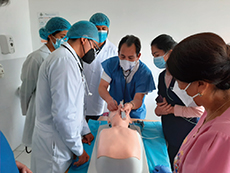Master Techniques from Japan to the World 1
Aiming to Improve Medical Skills with Japan’s Quality, Easy-to-Use Teaching Materials!
—Contributing to the spread of simulation-based medical education in Ecuador—

The Rector of UCE and the Director of the Medical and Robotics Simulation Clinic testing a heart disease examination simulator at the press conference venue when the equipment arrived (Photo: Kyoto Kagaku Co., Ltd.)

Practical study on tracheal intubation by medical students of the Faculty of Medical Science of UCE (Photo: Kyoto Kagaku Co., Ltd.)
Simulation-based education*1 for learning the basics of medical practice through practical training has become a new global trend in the medical education sector, and its importance is recognized in Ecuador as well. The Faculty of Medical Sciences of the Central University of Ecuador (UCE) had prepared dedicated classrooms and equipment for this. However, as computer-controlled high-performance equipment had been introduced, it had become difficult for the University to do maintenance work on its own and update the dedicated software. Furthermore, they had problems such as a limited number of students who could participate in simulation practice at one time. UCE therefore asked Japan for support.
Around the same time, Mr. TAKAYAMA Toshiyuki, President of Kyoto Kagaku Co., Ltd. (Kyoto Prefecture), a manufacturer of medical simulators, visited Ecuador for a market survey of Latin America and visited UCE. “This encounter was truly miraculous. We visited UCE by pure chance, but it was at exactly the right time when our products were needed,” said Mr. Takayama.
Mr. Takayama and employees of Kyoto Kagaku travelled back and forth between Ecuador and Japan several times in a period of just one month after receiving the request for support from UCE and developed a plan for a project while consulting with the JICA Ecuador Office as well. Subsequently, the company made an application to JICA’s SDGs Business Supporting Surveys, and the proposal was adopted. Then the Project for Strengthening Human Resources for Universal Health Coverage through Simulation-Based Medical Education was initiated from December 2019 (completion planned for January 2023).
Under this project, Kyoto Kagaku works with UCE as the counterpart institution to carry out simulation-based education verifications tailored to the local circumstances, using 48 types of medical and nursing education simulators containing 104 items made by Kyoto Kagaku (including physical examinations, medical procedures and care, perinatal and pediatric medical care, and disaster first aid and medical care). Immediately after the start of the project, COVID-19 countermeasures such as curfew restrictions were taken, and face-to-face classes were cancelled at UCE. Nevertheless, the demonstration event upon arrival of the equipment was broadly covered by the media, and expectations on the Ecuadorian side are growing.
Simulators of Kyoto Kagaku are unique in that they recreate the feeling of human skin by special materials and they are anatomically accurate. “When the UCE professors first touched the simulators, they noticed its high quality and expressed their excitement. It is also easy to maintain, as it is possible to replace deteriorating parts, for example injection pads where the needles for injections are inserted. They are suited to local conditions because UCE can purchase a variety of simulators as each one is not too expensive, and many students can practice at once,” said JICA Ecuador Office staff member Andrés Mencías.
Furthermore, as a unified curriculum for simulation-based education has not been developed in Ecuador, this project also supports the preparation of such curriculum. The preparation of a unified curriculum using Kyoto Kagaku’s simulators is expected to improve skills and provide a high level of practical training at 22 university medical schools in Ecuador, including UCE.
Concerning the future prospects, Mr. Takayama said, “We would like to improve the level of medical education in Ecuador as a whole with this project as a starting point. Furthermore, for Kyoto Kagaku as well, the project offers an opportunity to expand our business in Latin America, where we had no previous track record.”
The dream of Mr. Takayama and Kyoto Kagaku grows, hoping that the success of simulation-based education in Ecuador will lead to the improvement of medical education levels throughout Latin America.
*1 This refers to using expertly-developed medical simulators to learn techniques such as injection, suturing, and medical examinations in a form close to actual practice in order to train doctors, nurses, and other medical workers. It has drawn interest as a way to provide safe and secure medical services and also for the fact that, after the spread of COVID-19, direct contact with patients has become difficult.
Next Page >>
Main Text | Reference Statistics | Stories from the Field | Master Techniques from Japan to the World | ODA Topics
